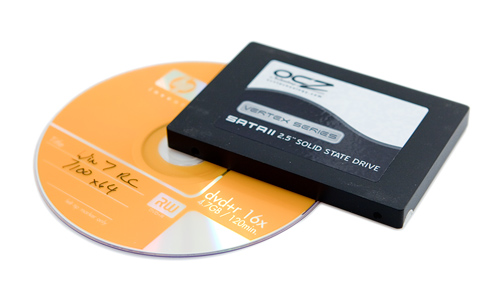Windows 7 HD and SSD Performance Analyzed
Windows 7 - TRIM
When Microsoft was developing Windows Vista, SSDs were still extremely niche, but they have since exploded in popularity due to their wide-scale usage in netbooks and overall massive price drops, along with disk and memory manufacturers putting substantial effort into making them a mass-market item. While they aren't quite a mass market item yet, the market has acted favorably towards them, and it's quite clear that in a few years, they will be commonplace. Microsoft realized this and built some SSD-specific tricks into Windows 7 which help these drives perform better and last longer.
If the drive broadcasts itself as a solid state drive (which can be done through the latest ATA specification), Windows 7 can make adjustments to ensure that the drive performs at its best. For example, if Windows 7 can verify that you're running a solid state disk, it will disable defragmentation for that drive (as defragging puts un-necessary wear on SSD's and doesn't help performance). Windows 7 will also enable support for "TRIM", also known as DisableDeleteNotify, an add-on to the ATA specification which allows for enhanced performance and decreased strain on the drive. According to Microsoft, here's what TRIM brings to the table.
- Enhancing device wear leveling by eliminating merge operation for all deleted data blocks
- Making early garbage collection possible for fast write
- Keeping device’s unused storage area as much as possible; more room for device wear leveling.
Basically, Windows 7 will send TRIM commands down the storage chain, but it's up to the drive to accept the commands and utilize them. In order for TRIM to work, you not only need Windows 7, but you'll need a solid state hard disk which has support for TRIM via its Firmware. Currently, these drives are few and far between, but we were able to test OCZ's new Vertex 120 GB SSD, which has support for TRIM in its latest firmware. We ran benchmarks with an older, non-TRIM supported firmware along with the latest version with TRIM support. Here's what we saw.


When Windows 7 detects a proper SSD and treats it as such, we see improvements in both read and write performance. Most notably, we see minimum read/write transfer speeds improve, and burst transfer rates also see slight bumps as well. TRIM is not designed as a performance improving feature per se, but we are seeing performance improvements here. TRIM is more designed for SSD device longevity, but a side effect of its garbage detection and early deletion feature does improve write performance in some circumstances.
* TRIM is not properly supported in the OCZ Vertex series firmware at this time. The performance differences seen here are likely due to changes made to different firmwares more than anything else. We'll update this page when proper support is implemented.
Of course, we would urge all SSD manufacturers to get on the TRIM bandwagon before Windows 7 is released later this year. Microsoft has also put forward an initiative to label TRIM-enabled SSDs as Windows 7-ready with a special logo, but we have not seen any forward momentum with this initiative yet.







